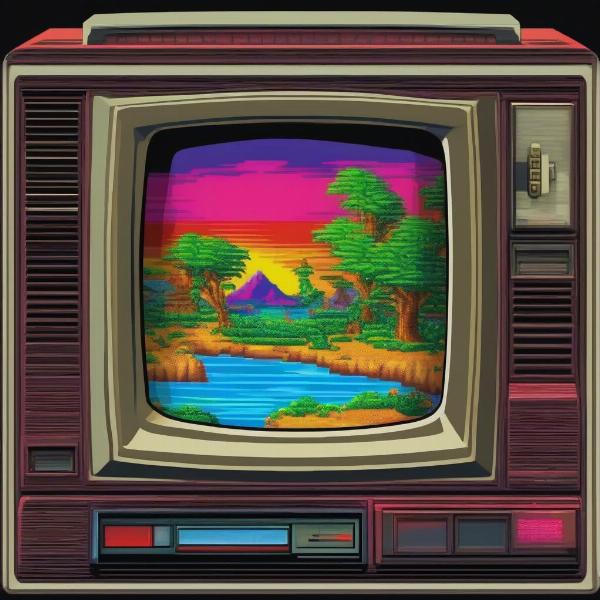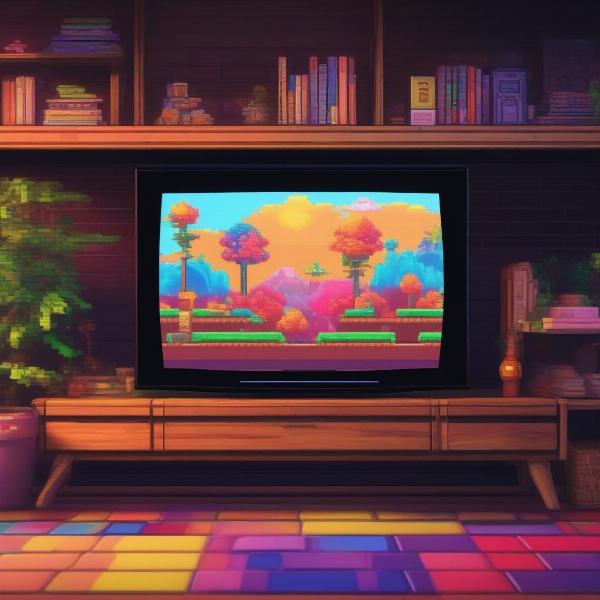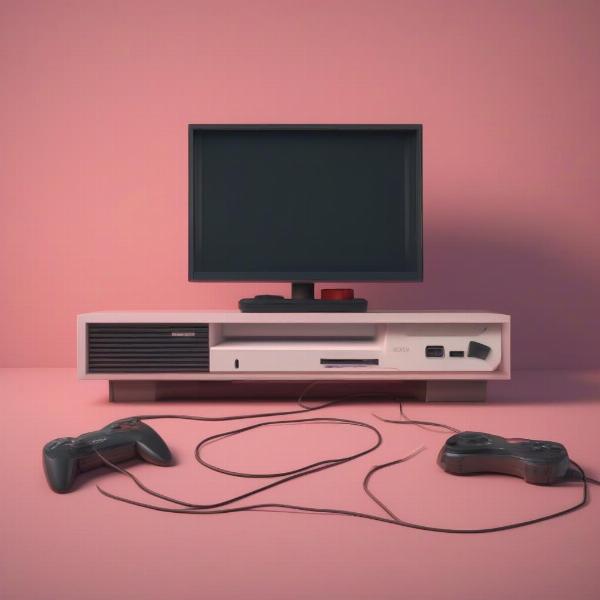Retro gaming is experiencing a massive resurgence, and for good reason. The charm of classic consoles and games is undeniable, but enjoying them fully requires the right setup, especially when it comes to your display. At SupremeDuelist.blog, we’re dedicated to helping you get the most out of your gaming experiences. This article dives deep into crafting the Best Tv Setup For Retro Games, covering everything from display technology to essential accessories.
We’ll explore the nuances of various television technologies and their impact on retro gaming visuals and latency. Choosing the right display is crucial for preserving the original aesthetic and responsiveness of those cherished games. Whether you’re a purist seeking the authentic experience or you’re happy to compromise with modern technology, this article has you covered.
Why the Right TV Matters for Retro Gaming
Playing retro games on modern televisions can sometimes feel off. This is primarily due to how modern TVs process older, lower-resolution signals. Many older games were designed for CRT (Cathode Ray Tube) televisions, which have a very different way of displaying images compared to modern LCD (Liquid Crystal Display) or OLED (Organic Light Emitting Diode) screens. CRT screens have an instant pixel response, while LCD and OLED screens can have input lag, which is the delay between you pressing a button and the action appearing on the screen. This can be a significant issue for fast-paced retro titles where timing is critical. If you are also looking to enhance the controller experience, you may want to check out the best bluetooth game controller for the ultimate retro feel.
Understanding CRT vs. Modern Displays
CRT TVs display images by firing electrons onto a phosphor-coated screen, producing a very sharp and pixel-perfect picture at lower resolutions. They also have no inherent input lag. Modern displays, such as LCD and OLED, use a grid of pixels and digital signal processing to create an image. While they offer higher resolutions and more vibrant colors, they can struggle with lower resolution images and may introduce unwanted input lag. For retro games, input lag can make gameplay feel sluggish and unresponsive. Additionally, scaling algorithms used by modern TVs can sometimes distort the visual style of retro games.
 crt-tv-setup-for-retro-gaming
crt-tv-setup-for-retro-gaming
The Issue of Input Lag
Input lag is a crucial factor when playing retro games. A delay in input response can be incredibly frustrating, especially in platformers or fighting games that require precise timing. While modern TVs have improved their latency, they are still generally not as responsive as a CRT display. This can make retro games feel slower and more difficult to control. In addition to the right TV, you might also need the right accessories. For those looking to take their classic game experience on the go, you should investigate the best retro games stick, which can be easily plugged into any screen.
Choosing the Right Modern TV for Retro Games
If using a CRT isn’t an option, there are some modern TV options you can consider for playing retro games. While no modern display will perfectly replicate the experience of a CRT, some perform better than others.
Low Input Lag is Key
The most critical factor to consider when using modern TVs is input lag. Look for a television that has a low input lag, ideally below 20ms. You can find this information in the TV’s specifications or in reviews. Gaming monitors are sometimes a better option than TVs because they tend to prioritize lower response times. Look for TVs and monitors that have a “game mode,” which often bypasses some of the image processing to achieve lower input lag.
Scaling Considerations
Another challenge with modern TVs is how they scale the lower resolution output of retro games. Some TVs do a better job than others, but you may also find an upscaler to enhance the image quality. Upscalers can improve the visual quality without distorting the aspect ratio, as well as reducing blurring. Many gamers find that upscalers help bridge the gap between older games and modern TVs.
“It’s all about balance,” explains video game historian Dr. Eleanor Vance. “While a CRT is often the purist’s choice, modern displays can provide excellent retro gaming experiences when correctly configured.”
HDR and Retro Games
High Dynamic Range (HDR) is a feature found on many modern TVs. While HDR can make modern games look incredible, it’s typically not useful for retro games. Retro games were not designed to output an HDR signal, and attempting to force HDR on them can result in a washed-out or unnatural-looking picture. It is important to turn off any HDR setting to get the best picture when playing old games.
Best TV Types for Retro Games: A Detailed Look
While modern TVs aren’t ideal for retro games in all scenarios, some technologies perform better than others. Here’s a breakdown of different TV types and how they stack up for retro gaming.
LCD (Liquid Crystal Display) TVs
LCD TVs are a common choice and are available in a wide range of sizes and prices. LCD TVs can work well for retro gaming if you choose a model with low input lag. However, these can sometimes struggle with lower resolutions and can have issues with backlight bleed, which can be more noticeable when displaying darker scenes. For LCD TVs, find a 1080p model for optimal performance with older games.
OLED (Organic Light Emitting Diode) TVs
OLED TVs offer exceptional contrast and color accuracy, with perfect black levels. They also typically have low input lag, making them a better choice than LCDs for retro gaming. The main downside is that OLED TVs tend to be more expensive. Another consideration is potential burn-in, which can happen if static images, such as heads-up displays or logos, are displayed for extended periods. While not usually a problem for varied retro game play, it is worth being aware of.
Gaming Monitors
Gaming monitors often prioritize low input lag and fast response times, making them a great option for retro gaming. They typically come with smaller screen sizes compared to TVs, but they excel in performance, often offering 120 Hz or even 144 Hz refresh rates, which can reduce motion blur. As gaming monitors are designed for PC gaming, you may find great success using them to play classic games if you are interested in the best 4k pc games as well as your old favorites.
 oled-tv-with-retro-games
oled-tv-with-retro-games
Projectors
Projectors can offer a larger screen size and a unique experience but typically do not have the best image quality or latency. They are often not a good option for retro gaming as they can struggle with lower resolutions and can introduce input lag. Projectors often work best for viewing movies or other media.
Essential Settings and Accessories
Optimizing your TV for retro games goes beyond just selecting the right display. There are a few key settings and accessories that can enhance your retro gaming experience.
Game Mode Settings
As mentioned previously, game mode is a critical setting on modern TVs. It reduces input lag by bypassing some of the TV’s image processing, which can improve the overall response time. Activating game mode can make a noticeable difference in how retro games play.
Aspect Ratio
Retro games often used a 4:3 aspect ratio, while modern TVs have a 16:9 aspect ratio. For the most authentic experience, you’ll want to choose 4:3 on your display. This will introduce black bars on the sides of the image, but will prevent any stretching or distortion. Some TVs also offer settings such as “pixel-perfect” or “dot-by-dot,” which will prevent any unwanted scaling of the display.
Video Upscalers
Upscalers like the RetroTINK or the OSSC (Open Source Scan Converter) can be a great investment for serious retro gamers. These devices can improve the visual quality of older games, providing a sharper and cleaner image, and they reduce the amount of input lag added by your television.
Retro Game Consoles and Emulators
Using original retro consoles provides the most authentic experience, but they can be harder to connect to modern TVs without the use of upscalers or converters. Retro emulation offers a convenient option for playing many old titles on a modern device. Be sure to select an emulator that has low latency and good accuracy when emulating the original console. You can also check out the best way to play retro games for more information on different setup methods.
“The beauty of retro games lies not just in the games themselves,” adds gaming enthusiast David Chen, “but also in recreating the experiences we had when we first played them.”
 retro-console-on-modern-tv
retro-console-on-modern-tv
FAQs About Retro Gaming TV Setups
What is the best TV size for retro games?
The best size often comes down to personal preference. Smaller screens are more in line with the original CRT monitors. However, a medium-sized 32-43 inch television works for most setups and offers a balance between immersion and size.
Do I need a CRT TV for retro gaming?
While a CRT TV provides the most authentic experience, they are not always a convenient option. Modern TVs with low input lag, paired with the right settings and upscalers can offer a great experience.
Can I play retro games on a 4k TV?
Yes, you can play retro games on a 4k TV, but you need to consider input lag, scaling, and ensure the appropriate settings to optimize the experience. 4K resolution will not benefit the game itself, it is just the output of the signal.
What is the best aspect ratio for retro games on a modern TV?
Using a 4:3 aspect ratio is the best option for maintaining the original look and feel of older games. Some TVs also offer a “pixel perfect” setting which helps to ensure pixel accuracy.
How can I reduce input lag on my modern TV?
You can reduce input lag by enabling game mode, disabling unnecessary image processing, using a lower resolution, and choosing a television that has low input lag.
Conclusion: Setting the Stage for Retro Gaming Excellence
Choosing the best tv setup for retro games involves balancing between authenticity and modern conveniences. While CRT TVs offer the most genuine experience, modern TVs with low input lag and proper settings can offer an enjoyable alternative. The key is to choose a display that prioritizes low input lag, and understand the limitations of modern displays when it comes to classic consoles. By paying attention to settings, aspect ratios, and the use of upscalers, you can set the stage for a truly great retro gaming experience. At SupremeDuelist.blog, we hope that this guide empowers you to enjoy the classics the best way possible. Come back again soon for more tips, tricks, and all things gaming!
Leave a Reply